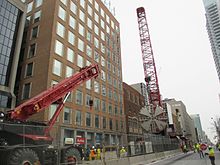Public transportation in Toronto
Public transportation in the Canadian city of Toronto dates back to 1849 with the creation of a horse-drawn stagecoach company.
Williams Omnibus Bus Line was the first mass transportation system in the old City of Toronto, Ontario, Canada with four six-passenger buses.
Established in 1849 by local cabinetmaker Burt Williams, it consisted of horse-drawn stagecoaches operating from the St. Lawrence Market to the Red Lion Hotel in Yorkville.
In 1861, the city gave a 30-year franchise to Toronto Street Railway, which built a horse car line, and the gauge of the buses was modified so as to fit between the tracks.
After the Williams Omnibus Bus Line had become heavily loaded in 1861, the city of Toronto issued a transit franchise (Resolution 14, By-law 353) for a horse-drawn street railway.
The Great Depression and World War II both placed heavy burdens on the ability of municipalities to finance themselves.
The TTC realized that improvements had to be made, despite the depression, and in 1936, purchased the first of the newly developed Presidents' Conference Committee (PCC) streetcars, which are custom-designed.
Ironically, the one municipal service that prospered during the war years was public transit; employers had to stagger work hours in order to avoid overcrowding the streetcars.
Toronto continued their program of purchasing PCC cars, running the world's largest fleet, including many obtained second-hand from U.S. cities that abandoned streetcar service.
The assets and liabilities of the TTC and four independent bus lines operating in the suburbs were acquired by the Commission.
In 1954, the TTC became the sole provider of public transportation services in Metro Toronto until the creation of GO Transit in 1968.
The GO network employs double-decker diesel trains and coach buses; it connects with other regional transit providers such as the TTC and Via Rail.
The Terminal Link is a people mover monorail hybrid located in Toronto Pearson International Airport.
The rest of the city is primarily served by a network of about 150 bus routes, many of them forming a grid along main streets, and all of them (except for routes 99 and 171, both of which connect to bus garages, and 176 Mimico GO, which serves Mimico GO Station) connecting to one or more subway stations.
A more distinctive feature of the TTC is the streetcar system, one of the few remaining in North America with a substantial amount of in-street operation.
As part of the Transit City proposal, the line was originally planned to start construction in 2009 with a 2013 opening date.
In 2017, the average amount of time people spend commuting with public transit in Toronto, for example to and from work, on a weekday is 96 minutes.







